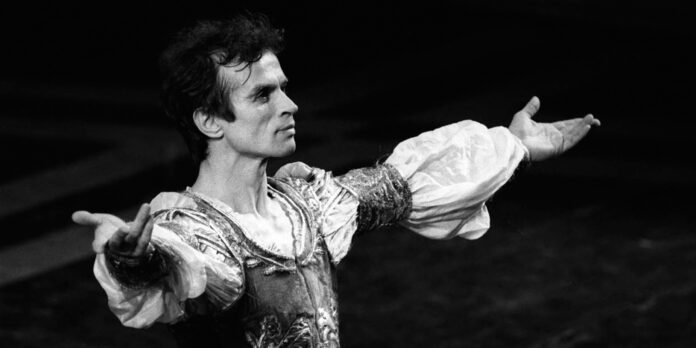L’eredità di Nureyev
Alla Scala si torna in streaming alle coreografie di Rudolf Nureyev, il fuggitivo che nel 1961 scelse l’ovest sfidando i servizi segreti russi nel famoso abbraccio con i poliziotti francesi all’aeroporto di Parigi, l’esiliato viaggiante a lungo apolide, il rianimatore del balletto in Occidente, a partire dalle radici doc pietroburghesi con il gusto però di ricamarci sopra tanti passi, virtuosismi ardui e intricati.
Manuel Legris, il nuovo direttore francese all’Opéra de Paris, di carriera nureyeviana, gli ha reso omaggio programmando una serata di estratti dai titoli di grande repertorio “à la Rudy”. Dopo l’epoca d’oro in cui alla testa della compagnia milanese operò il russo Makhar Vaziev, ora a capo del balletto del Bolshoi di Mosca, che portò una ventata nuova promuovendo i giovani e nominando coreografo residente Alexei Ratmanky, quei giovani sono di nuovo alle prese con Nureyev.
Cresciuto nell’epoca in cui non era più necessario scappare per danzare e coreografare fuori dall’ex URSS, Ratmansky, nato nel 1968, è “il” nuovo nome mondiale della coreografia russa”; già direttore al Bolshoi, adesso è autore residente all’American Ballet Theatre. Ma è di nuovo Nureyev la figura-mito ereditata dai tempi della guerra fredda, per sempre agli onori nel tempio del balletto italiano per via francese.
Il balletto e la Guerra Fredda
Bisogna, a questo punto, ricordare che il balletto dal secondo dopoguerra è sempre stata una delicata questione di geopolitica culturale e che ogni orientamento artistico è stato sempre una precisa scelta di campo, ivi compresi i paesi satelliti dell’Unione Sovietica.
Solo Cuba, con Alicia Alonso, scelse la propria via nazionale al balletto, russo-americana-caraibica, amica dei sovietici, ma non moscovita o pietroburghese.
Dagli Stati Uniti, dove il balletto faticò ad avere cittadinanza, perché considerato prodotto elitario e a-democratico del Vecchio Continente, affermandosi alla fine in nuove vesti anti-romantiche e con plot americani, sulla linea estetica dei fuorusciti russi George Balanchine-Mikhail Mordkin, le compagnie USA furono inviate per il tramite di Fondazioni ed Enti-paravento della CIA come ambasciatrici culturali in Europa in funzione antisovietica, sia al Festival di Spoleto sia alla Biennale Musica di Venezia.
Ma alcuni artisti moscoviti, rappresentanti dell’URSS, Vladimir Vasiliev, Ekaterina Maximova e Maya Plisetskaya, intanto si esibirono al Festival di Nervi con l’autorizzazione a superare la cortina di ferro, auspice Iréne Lidova, russo-francese.
Nei parchi della cittadina ligure giunsero anche gli artisti inglesi, laddove il balletto era fiorito dalla costola dei Ballets Russes di Sergej Diaghilev recentemente, alla fine degli anni venti del 900.
Nureyev’s legacy
At La Scala, we return to streaming to the choreography of Rudolf Nureyev, the fugitive who in 1961 chose the west by challenging the Russian secret services in the famous embrace with the French policemen at the Paris airport, the long-term stateless traveling exile, the reanimator of ballet in the West, starting from the St. Petersburg DOC roots with the pleasure, however, of embroidering many steps on it, arduous and intricate virtuosity.
Manuel Legris, the new French director of the Paris Opera, of Nureyevian career, paid tribute to him by planning an evening of excerpts from the titles of great repertoire “à la Rudy”.
After the golden age in which the Russian Makhar Vaziev operated at the head of the Milanese company, now in charge of the ballet of the Bolshoi in Moscow, who brought a new breath promoting young people and nominating resident choreographer Alexei Ratmanky, those young people are again grappling with Nureyev.
Raised at a time when it was no longer necessary to run away to dance and choreograph out of the former URSS, Ratmansky (born in 1968), is “the new world name of Russian choreography”; former director at the Bolshoi, he is now a resident author at the American Ballet Theatre.
But, Nureyev is again the myth-figure inherited from the Cold War, forever to the honours in the temple of Italian ballet via French.
Ballet and Cold War
It should be remembered, at this point, that ballet since the Second World War has always been a delicate matter of cultural geopolitics and that every artistic orientation has always been a precise choice of field, including the Satellite Countries of the Soviet Union. Only Cuba, with Alicia Alonso, chose his national path to ballet, Russian-American-Caribbean, friend of the Soviets, but not Muscovite or Petersburg.
From the United States, where ballet struggled to have citizenship, because it is considered an elitist and a-democratic product of the Old Continent, eventually establishing itself in new anti-romantic guises and with American plots, on the aesthetic line of the Russian exiles George Balanchine-Mikhail Mordkin. US companies were sent through CIA foundations and screen bodies as cultural ambassadors to Europe in an anti-Soviet function, both at the Spoleto Festival and at the Venice Biennale of Music.
But some Muscovite artists, representing the USSR, Vladimir Vasiliev, Ekaterina Maximova e Maya Plisetskaya, meanwhile they performed at the Nervi Festival with permission to overcome the Iron Curtain, hoped Iréne Lidova, Russian-French. English artists also came to the parks of the Ligurian town, where ballet had flourished from the rib of Sergej Diaghilev’s Ballets Russes recently, in the late 1920s.








